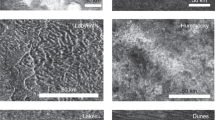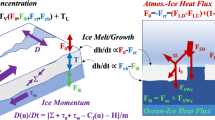Abstract
Saturn's moon Titan is the second largest natural satellite in the solar system, and the only one that possesses a substantial atmosphere. With a surface temperature of 93.7 K at the equator, Titan's water is almost completely frozen out of the atmosphere; water ice comprises between 35% and 45% of the mass of Titan depending on the interior model. But methane seems to play many of the roles on Titan that water does on Earth: clouds have been observed, fluvial and dendritic features have been imaged suggesting episodic heavy rainfall, and there is compelling but circumstantial evidence for near-polar lakes or seas of methane and its atmospheric photochemical product, ethane. However, whereas Earth possesses a massive global ocean of water, Titan lacks a global methane ocean, and on Titan, low-latitude rainfall appears to be an occasional process limited by the small amount of available solar energy compared with that of Earth. Titan is therefore distinct from the Earth, but is also different from Venus in retaining an active cycle of precipitation and evaporation, and from Mars in the preponderance of active fluvial and pluvial processes in the present day.
This is a preview of subscription content, access via your institution
Access options
Subscribe to this journal
Receive 12 print issues and online access
$259.00 per year
only $21.58 per issue
Buy this article
- Purchase on Springer Link
- Instant access to full article PDF
Prices may be subject to local taxes which are calculated during checkout



Similar content being viewed by others
References
Lebreton, J.-P. et al. An overview of the descent and landing of the Huygens probe on Titan. Nature 438, 758–764 (2005).
Niemann, H. B. et al. The abundances of constituents of Titan's atmosphere from the GCMS instrument on the Huygens probe. Nature 438, 779–784 (2005).
Tyler, G. L. et al. Radio science investigation of the Saturn System with Voyager 1: preliminary results. Science 212, 201–206 (1981).
Fulchignoni, M. et al. Titan's physical characteristics measured by the Huygens Atmospheric structure instrument (HASI). Nature 438, 785–791 (2005).
Atreya, S. K. et al. Titan's methane cycle. Planet.Space Sci. 54, 1177–1187 (2006).
Tokano, T. et al. Methane drizzle on Titan. Nature 442, 432–435 (2006).
Tomasko, M. G. et al. Rain, winds and haze during the Huygens probe's descent to Titan's surface. Nature 438, 765–778 (2005).
Roe, H. G., Brown, M. E., Schaller, E. L., Bouchez, A. H. & Trujillo, C. A. Geographic control of Titan's mid-latitude clouds. Science 310, 477–479 (2005).
Griffith, C. et al. The evolution of Titan's mid-latitude clouds. Science 310, 474–476 (2005).
Griffith, C. A. Hall, J. L. & Geballe, T. R. Detection of daily clouds on Titan. Science 290, 509–513 (2000).
Porco, C. C. et al. Imaging of Titan from the Cassini spacecraft. Nature 434, 159–168 (2005).
Schaller, E. L. et al. Dissipation of Titan's south polar clouds. Icarus 184, 517–523 (2006).
Griffith, C. A. et al. Evidence for a polar ethane cloud on Titan. Science 313, 1620–1622 (2006).
Hueso, R. & Sanchez-Lavega, A. Methane storms on Saturn's moon Titan. Nature 442, 428–431 (2006).
Yung, Y. L., Allen, M. A. & Pinto, J. P. Photochemistry of the atmosphere of Titan: comparison between model and observations. Astrophys. J. Suppl. S. 55, 465–506 (1984).
Atreya, S. K. Atmospheres and Ionospheres of the Outer Planets and Satellites. (Springer-Verlag, Berlin, 1986).
Waite, J. H. et al. The process of tholin formation in Titan's atmosphere. Science 316, 870–872 (2007).
Wilson, E. H. & Atreya, S. K. Current state of modelling the photochemistry of Titan's mutually dependent atmosphere and ionosphere. J. Geophys. Res. 109, E06002 (2004).
Lunine, J. I., Stevenson, D. J. & Yung, Y. L. Ethane ocean on Titan. Science 222, 1229–1230 (1983).
Coustenis, A. et al. The composition of Titan's stratosphere from Cassini/CIRS mid-infrared spectra. Icarus 189, 35–62 (2007).
Dubouloz, N., Raulin, F., Lellouch, E. & Gautier, D. Titan's hypothesized ocean properties — The influence of surface temperature and atmospheric composition uncertainties. Icarus 82, 81–96 (1989).
West, R., Brown, M. E., Salinas, S. V., Bouchez, A. H. & Roe, H. G. No oceans on Titan from the absence of a near-infrared specular reflection. Nature 436, 670–672 (2005).
Stofan, E. R. et al. The lakes of Titan. Nature 445, 61–64 (2007).
Elachi, C. et al. Cassini radar views the surface of Titan. Science 308, 970–974 (2005).
Whiffen, D. H. Measurements on the absorption of microwaves. Part IV.— Non-polar liquids. Trans. Faraday Soc. 46, 124–130 (1950).
Lellouch, E., Schmitt, B., Coustenis, A., Cuby, J.-G. Titan's 5-micron lightcurve. Icarus 168, 209–214 (2003).
Rannou, P. Montmessin, F. Hourdin, F., Lebonnois, S. The latitudinal distribution of clouds on Titan. Science 311, 201–205 (2006).
Mitri, G., Showman, A. P., Lunine, J. I. & Lorenz, R. D. Hydrocarbon lakes on Titan. Icarus 186, 385–394 (2007).
Kirk, R. et al. in AGU Fall Meeting abstract P22B-01 (AGU, Washington DC, San Francisco, 2007).
Lorenz, R. D. Fluvial Channels on Titan: Initial Cassini Radar Observations. Planet. Space Sci. (in the press).
Soderblom, L. et al. Topography and Geomorphology of the Huygens landing site on Titan. Planet. Space Sci. 55, 2015–2044 (2007).
Lorenz, R. D. Griffith, C., Lunine, J. I., McKay, C. P. & Renno, N. O. Convective plumes and the scarcity of Titan's clouds. Geophys. Res. Lett. 32, L01201 (2005).
Lorenz, R. D. Niemann, H. B., Harpold, D. N., Way, S. H. & Zarnecki, J. C. Titan's damp ground: Constraints on Titan surface thermal properties from the temperature evolution of the Huygens GCMS inlet. Meteorit. Planet. Sci. 41, 1705–1714 (2006).
Lunine, J. I. and Stevenson, D. J. Formation of the Galilean satellites in a gaseous nebula. Icarus 52, 14–39 (1982).
Hersant, F., Gautier, D., Tobie, G. & Lunine, J. I. Interpretation of the carbon abundance in Saturn measured by Cassini. Planet. Space Sci. (submitted).
McCord, T. et al. Titan's surface: Search for spectral diversity and composition using the Cassini VIMS investigation. Icarus (in the press).
Osegovich, J. P. & Max, M. D. Compound clathrate hydrate on Titan's surface. J. Geophys. Res. 110, E08005 (2005).
Fortes, A. D. & Stofan, E. in 36th Lunar Planet. Sci. Conference Abstract 1123 (Lunar and Planetary Institute, 2005).
Tobie, G. Grasset, O., Lunine, J. I., Mocquet, A., Sotin, C. Titan's internal structure inferred from a coupled thermal-orbital model. Icarus 175, 496–502 (2005).
Sohl, F., Hussman,n, H., Schwentker, B., Spohn, T., Lorenz, R. D. Interior structure models and tidal Love numbers of Titan. J. Geophys. Res. 108 (E12), 5130 (2003).
Tobie, G., Lunine, J. I. & Sotin, C. Episodic outgassing as the origin of atmospheric methane on Titan. Nature 440, 61–64 (2006).
Fortes, A. D. Grinrod, P. M., Trickett, S. K., Vocadlo, L. Ammonium sulfate on Titan: Possible origin and role in cryvolcanism. Icarus 188, 139–153 (2007).
Lorenz, R. D., McKay, C. P. & Lunine, J. I. Photochemically-induced collapse of Titan's atmosphere. Science 275, 642–644 (1997).
Lorenz, R. D. et al. Titan's inventory of organic surface materials. Geophys. Res. Lett. 35, L02206 (2008).
Stevenson, D. J. in Proc. Symp. on Titan, Toulouse, September 1991 29–33 (European Space Agency, Noordwijk, The Netherlands, 1992).
Coustenis, A. et al. Titan's atmosphere from ISO mid-infrared spectroscopy. Icarus 161, 383 (2003).
Atreya, S. K. Titan's organic factory. Science 316, 843–845 (2007).
Kasting, J. F. Runaway and moist greenhouse atmospheres and the evolution of Earth and Venus. Icarus 74, 472–494 (1988).
Pujol, T. & North, G. R. Runaway greenhouse effect in a semigray radiative-convective model. J. Atmospheric Sci. 59, 2801–2810 (2002).
Lorenz, R. D., Lunine, J. I. & McKay, C. P. Titan under a red giant sun: A new kind of “habitable” moon. Geophys. Res. Lett. 24, 2905–2908 (1997).
The Limits of Organic Life in Planetary Systems (National Academies Press, Washington DC, 2007).
Lorenz, R. D., Lunine, J. & Zimmerman, W. Post-Cassini exploration of Titan: Science goals, instrumentation and mission concepts. Adv. Space Res. 36, 281–285 (2005).
Lindal, G. F. et al. The atmosphere of Titan — an analysis of the Voyager 1 radio occulation measurements. Icarus 53, 348–363 (1983).
Hunten, D. The sequestration of ethane on Titan in smog particles. Nature 443, 669–670 (2006).
Acknowledgements
We thank Chris McKay for improving the manuscript. The Cassini-Huygens project and NASA Planetary Atmospheres Program supported the work of the authors. J.I.L was a visiting professor at IFSI-INAF, Rome, Italy, during the final revision of the manuscript, and is grateful to its director Angioletta Coradini for the Institute's hospitality.
Author information
Authors and Affiliations
Corresponding author
Rights and permissions
About this article
Cite this article
Lunine, J., Atreya, S. The methane cycle on Titan. Nature Geosci 1, 159–164 (2008). https://doi.org/10.1038/ngeo125
Published:
Issue Date:
DOI: https://doi.org/10.1038/ngeo125
This article is cited by
-
Science goals and new mission concepts for future exploration of Titan’s atmosphere, geology and habitability: titan POlar scout/orbitEr and in situ lake lander and DrONe explorer (POSEIDON)
Experimental Astronomy (2022)
-
A post-Cassini view of Titan’s methane-based hydrologic cycle
Nature Geoscience (2018)
-
Transient features in a Titan sea
Nature Geoscience (2014)



